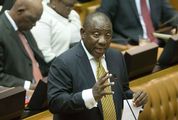DECEMBER is always a delicate time in the foreign exchange market. Everyone goes off on holiday and liquidity dwindles, raising the risk that just one or two trades can cause huge swings in the rate.
That was the story of the rand’s crash in December 2000, when it plummeted to R14 to the dollar. With the rand looking as delicate as it does now, the holiday season risk will need careful watching.
The rand is volatile at the best of times, but in recent days has been all over the place. The big question is still when US Federal Reserve (Fed) "tapering" will begin, and what its effect will be. Latest US data have left markets more divided than ever about the answer, and the rand’s prospects more uncertain.
Markets were watching Friday’s US jobs data to see whether the Fed might soon start reducing monetary stimulus. The data looked good, with 203,000 jobs created and unemployment at 7%.
Many economists now think tapering could begin this month, which would be bad for emerging market currencies. But even more still believe that it won’t happen before next year.
Amid the confusion, emerging market currencies were unexpectedly buoyant on Friday. Even the rand, which had hit an almost five year low of R10.58 to the dollar on Thursday, recovered to R10.33.
But it is still the worst performing major currency, down more than 20% this year. With reason: South Africa’s current account deficit is almost 7% of gross domestic product. We need large inflows of foreign capital to finance this, and until October we had them. But last month foreigners headed for the exits, selling a net R36.3bn of bonds and equities, so that net capital inflows this year have fallen to R25.1bn, from R91bn last year.
It could get worse. The urgent message is that action must be taken to address the current account deficit, and to maximise South Africa’s attractions as an investment destination.

Picture: REUTERS
DECEMBER is always a delicate time in the foreign exchange market. Everyone goes off on holiday and liquidity dwindles, raising the risk that just one or two trades can cause huge swings in the rate.
That was the story of the rand’s crash in December 2000, when it plummeted to R14 to the dollar. With the rand looking as delicate as it does now, the holiday season risk will need careful watching.
The rand is volatile at the best of times, but in recent days has been all over the place. The big question is still when US Federal Reserve (Fed) "tapering" will begin, and what its effect will be. Latest US data have left markets more divided than ever about the answer, and the rand’s prospects more uncertain.
Markets were watching Friday’s US jobs data to see whether the Fed might soon start reducing monetary stimulus. The data looked good, with 203,000 jobs created and unemployment at 7%.
Many economists now think tapering could begin this month, which would be bad for emerging market currencies. But even more still believe that it won’t happen before next year.
Amid the confusion, emerging market currencies were unexpectedly buoyant on Friday. Even the rand, which had hit an almost five year low of R10.58 to the dollar on Thursday, recovered to R10.33.
But it is still the worst performing major currency, down more than 20% this year. With reason: South Africa’s current account deficit is almost 7% of gross domestic product. We need large inflows of foreign capital to finance this, and until October we had them. But last month foreigners headed for the exits, selling a net R36.3bn of bonds and equities, so that net capital inflows this year have fallen to R25.1bn, from R91bn last year.
It could get worse. The urgent message is that action must be taken to address the current account deficit, and to maximise South Africa’s attractions as an investment destination.

























Register/Login
Close XMy News
You can only set up or view personalised news headlines when you are logged in as a registered user. Thereafter you can choose the sectors of industry in which you are interested, and the latest articles from those sectors will display in this area of your console.
Login or Register.Top Stories
My Watchlist
You can only set up or view your share watchlist when you are logged in as a registered user. Thereafter you can select a list of companies and enter your share details to monitor their performance.
Login or Register.My Clippings
You can only clip articles when you are logged in as a registered user. Thereafter you can click on the "Read later" icon at the top of an article to save it to this area of your console, where you can return to read it at any time.
Login or Register.Change: -1.21%
Change: -1.31%
Change: -1.11%
Change: -1.12%
Change: -2.16%
Data supplied by Profile Data
Change: 0.00%
Change: 0.00%
Change: -1.21%
Change: 0.00%
Change: 0.00%
Data supplied by Profile Data
Change: 0.00%
Change: 0.03%
Change: -0.01%
Change: -0.09%
Change: -0.29%
Data supplied by Profile Data
Change: 0.00%
Change: 0.00%
Change: 0.00%
Change: 0.00%
Change: 0.00%
Data supplied by Profile Data